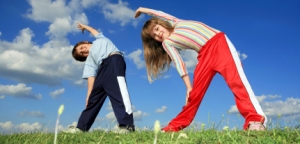Try any combination of these classic moves to get students’ heart rates elevated and their minds focused for classroom learning. Move for 10-15 minutes, and play music if you like.
- Plies (knee bends)
- Rises (heels lifts)
- Shoulder rolls (forward and back)
- Arm circles (one or both arms, same or opposite directions)
- Leg swings (front & back, side to side or circular)
- Twists (with arms or shoulders, hips, out to the side or overhead)
- Jumps, Hops & Leaps (on two legs or one, on the spot or moving around the room)
- Jumping Jacks (with arms overhead, behind the back, or playing “pattycake” with a partner)



